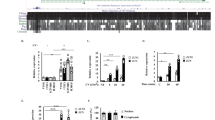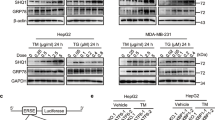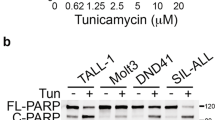Abstract
The transcription factor JUN is frequently overexpressed in multiple genetic subtypes of acute myeloid leukemia (AML); however, the functional role of JUN in AML is not well defined. Here we report that short hairpin RNA (shRNA)-mediated inhibition of JUN decreases AML cell survival and propagation in vivo. By performing RNA sequencing analysis, we discovered that JUN inhibition reduces the transcriptional output of the unfolded protein response (UPR), an intracellular signaling transduction network activated by endoplasmic reticulum (ER) stress. Specifically, we found that JUN is activated by MEK signaling in response to ER stress, and that JUN binds to the promoters of several key UPR effectors, such as XBP1 and ATF4, to activate their transcription and allow AML cells to properly negotiate ER stress. In addition, we observed that shRNA-mediated inhibition of XBP1 or ATF4 induces AML cell apoptosis and significantly extends disease latency in vivo tying the reduced survival mediated by JUN inhibition to the loss of pro-survival UPR signaling. These data uncover a previously unrecognized role of JUN as a regulator of the UPR as well as provide key new insights into the how ER stress responses contribute to AML and identify JUN and the UPR as promising therapeutic targets in this disease.
This is a preview of subscription content, access via your institution
Access options
Subscribe to this journal
Receive 12 print issues and online access
$259.00 per year
only $21.58 per issue
Buy this article
- Purchase on Springer Link
- Instant access to full article PDF
Prices may be subject to local taxes which are calculated during checkout





Similar content being viewed by others
References
Döhner H, Estey EH, Amadori S, Appelbaum FR, Büchner T, Burnett AK et al. Diagnosis and management of acute myeloid leukemia in adults: recommendations from an international expert panel, on behalf of the European LeukemiaNet. Blood 2010; 115: 453–474.
Cancer Genome Atlas Research Network. Genomic and epigenomic landscapes of adult de novo acute myeloid leukemia. N Engl J Med 2013; 368: 2059–2074.
Vogt PK . Jun, the oncoprotein. Oncogene 2001; 20: 2365–2377.
Shaulian E, Karin M . AP-1 as a regulator of cell life and death. Nat Cell Biol 2002; 4: E131–E136.
Rangatia J, Vangala RK, Singh SM, Peer Zada AA, Elsässer A, Kohlmann A et al. Elevated c-Jun expression in acute myeloid leukemias inhibits C/EBPalpha DNA binding via leucine zipper domain interaction. Oncogene 2003; 22: 4760–4764.
Elsässer A, Franzen M, Kohlmann A, Weisser M, Schnittger S, Schoch C et al. The fusion protein AML1-ETO in acute myeloid leukemia with translocation t(8;21) induces c-jun protein expression via the proximal AP-1 site of the c-jun promoter in an indirect, JNK-dependent manner. Oncogene 2003; 22: 5646–5657.
Staber PB, Linkesch W, Zauner D, Beham-Schmid C, Guelly C, Schauer S et al. Common alterations in gene expression and increased proliferation in recurrent acute myeloid leukemia. Oncogene 2004; 23: 894–904.
Li L, Li M, Sun C, Francisco L, Chakraborty S, Sabado M et al. Altered hematopoietic cell gene expression precedes development of therapy-related myelodysplasia/acute myeloid leukemia and identifies patients at risk. Cancer Cell 2011; 20: 591–605.
Sykes SM, Lane SW, Bullinger L, Kalaitzidis D, Yusuf R, Saez B et al. AKT/FOXO signaling enforces reversible differentiation blockade in myeloid leukemias. Cell 2011; 146: 697–708.
Walter P, Ron D . The unfolded protein response: from stress pathway to homeostatic regulation. Science 2011; 334: 1081–1086.
Wang M, Kaufman RJ . The impact of the endoplasmic reticulum protein-folding environment on cancer development. Nat Rev Cancer 2014; 14: 581–597.
Tabas I, Ron D . Integrating the mechanisms of apoptosis induced by endoplasmic reticulum stress. Nat Cell Biol 2011; 13: 184–190.
Woehlbier U, Hetz C . Modulating stress responses by the UPRosome: a matter of life and death. Trends Biochem Sci 2011; 36: 329–337.
Harding HP, Zhang Y, Zeng H, Novoa I, Lu PD, Calfon M et al. An integrated stress response regulates amino acid metabolism and resistance to oxidative stress. Mol Cell 2003; 11: 619–633.
Harding HP, Novoa I, Zhang Y, Zeng H, Wek R, Schapira M et al. Regulated translation initiation controls stress-induced gene expression in mammalian cells. Mol Cell 2000; 6: 1099–1108.
Ye J, Kumanova M, Hart LS, Sloane K, Zhang H, De Panis DN et al. The GCN2-ATF4 pathway is critical for tumour cell survival and proliferation in response to nutrient deprivation. EMBO J 2010; 29: 2082–2096.
Calfon M, Zeng H, Urano F, Till JH, Hubbard SR, Harding HP et al. IRE1 couples endoplasmic reticulum load to secretory capacity by processing the XBP-1 mRNA. Nature 2002; 415: 92–96.
Yoshida H, Matsui T, Yamamoto A, Okada T, Mori K . XBP1 mRNA is induced by ATF6 and spliced by IRE1 in response to ER stress to produce a highly active transcription factor. Cell 2001; 107: 881–891.
Lee K, Tirasophon W, Shen X, Michalak M, Prywes R, Okada T et al. IRE1-mediated unconventional mRNA splicing and S2P-mediated ATF6 cleavage merge to regulate XBP1 in signaling the unfolded protein response. Genes Dev 2002; 16: 452–466.
Yamamoto K, Sato T, Matsui T, Sato M, Okada T, Yoshida H et al. Transcriptional induction of mammalian ER quality control proteins is mediated by single or combined action of ATF6alpha and XBP1. Dev Cell 2007; 13: 365–376.
Lee AH, Iwakoshi NN, Glimcher LH . XBP-1 regulates a subset of endoplasmic reticulum resident chaperone genes in the unfolded protein response. Mol Cell Biol 2003; 23: 7448–7459.
Shaffer AL, Shapiro-Shelef M, Iwakoshi NN, Lee AH, Qian SB, Zhao H et al. XBP1, downstream of Blimp-1, expands the secretory apparatus and other organelles, increases protein synthesis in plasma cell differentiation. Immunity 2004; 21: 81–93.
Sriburi R, Bommiasamy H, Buldak GL, Robbins GR, Frank M, Jackowski S et al. Coordinate regulation of phospholipid biosynthesis and secretory pathway gene expression in XBP-1(S)-induced endoplasmic reticulum biogenesis. J Biol Chem 2007; 282: 7024–7034.
Sriburi R, Jackowski S, Mori K, Brewer JW . XBP1: a link between the unfolded protein response, lipid biosynthesis, and biogenesis of the endoplasmic reticulum. J Cell Biol 2004; 167: 35–41.
Szegezdi E, Logue SE, Gorman AM, Samali A . Mediators of endoplasmic reticulum stress-induced apoptosis. EMBO Rep 2006; 7: 880–885.
Zinszner H, Kuroda M, Wang X, Batchvarova N, Lightfoot RT, Remotti H et al. CHOP is implicated in programmed cell death in response to impaired function of the endoplasmic reticulum. Genes Dev 1998; 12: 982–995.
McCullough KD, Martindale JL, Klotz LO, Aw TY, Holbrook NJ . Gadd153 sensitizes cells to endoplasmic reticulum stress by down-regulating Bcl2 and perturbing the cellular redox state. Mol Cell Biol 2001; 21: 1249–1259.
Marciniak SJ, Yun CY, Oyadomari S, Novoa I, Zhang Y, Jungreis R et al. CHOP induces death by promoting protein synthesis and oxidation in the stressed endoplasmic reticulum. Genes Dev 2004; 18: 3066–3077.
Lu M, Lawrence DA, Marsters S, Acosta-Alvear D, Kimmig P, Mendez AS et al. Opposing unfolded-protein-response signals converge on death receptor 5 to control apoptosis. Science 2014; 345: 98–101.
Chevet E, Hetz C, Samali A . Endoplasmic reticulum stress-activated cell reprogramming in oncogenesis. Cancer Discov 2015; 5: 586–597.
Hetz C, Chevet E, Harding HP . Targeting the unfolded protein response in disease. Nat Rev Drug Discov 2013; 12: 703–719.
Sun H, Lin DC, Guo X, Masouleh BK, Gery S, Cao Q et al. Inhibition of IRE1α-driven pro-survival pathways is a promising therapeutic application in acute myeloid leukemia. Oncotarget 2016; 7: 18736–18749.
Schardt JA, Weber D, Eyholzer M, Mueller BU, Pabst T . Activation of the unfolded protein response is associated with favorable prognosis in acute myeloid leukemia. Clin Cancer Res 2009; 15: 3834–3841.
Schardt JA, Eyholzer M, Timchenko NA, Mueller BU, Pabst T . Unfolded protein response suppresses CEBPA by induction of calreticulin in acute myeloid leukaemia. J Cell Mol Med 2010; 14: 1509–1519.
Haefliger S, Klebig C, Schaubitzer K, Schardt J, Timchenko N, Mueller BU et al. Protein disulfide isomerase blocks CEBPA translation and is up-regulated during the unfolded protein response in AML. Blood 2011; 117: 5931–5940.
Krivtsov AV, Twomey D, Feng Z, Stubbs MC, Wang Y, Faber J et al. Transformation from committed progenitor to leukaemia stem cell initiated by MLL-AF9. Nature 2006; 442: 818–822.
Liberzon A, Subramanian A, Pinchback R, Thorvaldsdóttir H, Tamayo P, Mesirov JP . Molecular signatures database (MSigDB) 3.0. Bioinformatics 2011; 27: 1739–1740.
Shaulian E, Karin M . AP-1 in cell proliferation and survival. Oncogene 2001; 20: 2390–2400.
Uluçkan Ö, Guinea-Viniegra J, Jimenez M, Wagner EF . Signalling in inflammatory skin disease by AP-1 (Fos/Jun). Clin Exp Rheumatol 2015; 33 (4 Suppl 92): S44–S49.
Schonthaler HB, Guinea-Viniegra J, Wagner EF . Targeting inflammation by modulating the Jun/AP-1 pathway. Ann Rheum Dis 2011; 70 (Suppl 1): i109–i112.
Dombroski BA, Nayak RR, Ewens KG, Ankener W, Cheung VG, Spielman RS . Gene expression and genetic variation in response to endoplasmic reticulum stress in human cells. Am J Hum Genet 2010; 86: 719–729.
Han J, Back SH, Hur J, Lin YH, Gildersleeve R, Shan J et al. ER-stress-induced transcriptional regulation increases protein synthesis leading to cell death. Nat Cell Biol 2013; 15: 481–490.
Kent WJ, Sugnet CW, Furey TS, Roskin KM, Pringle TH, Zahler AM et al. The human genome browser at UCSC. Genome Res 2002; 12: 996–1006.
Rosenbloom KR, Sloan CA, Malladi VS, Dreszer TR, Learned K, Kirkup VM et al. ENCODE data in the UCSC Genome Browser: year 5 update. Nucleic Acids Res 2013; 41 (Database issue): D56–D63.
Raha D, Wang Z, Moqtaderi Z, Wu L, Zhong G, Gerstein M et al. Close association of RNA polymerase II and many transcription factors with Pol III genes. Proc Natl Acad Sci USA 2010; 107: 3639–3644.
Bagger FO, Rapin N, Theilgaard-Mönch K, Kaczkowski B, Thoren LA, Jendholm J et al. HemaExplorer: a database of mRNA expression profiles in normal and malignant haematopoiesis. Nucleic Acids Res 2013; 41 (Database issue): D1034–D1039.
Pulverer BJ, Kyriakis JM, Avruch J, Nikolakaki E, Woodgett JR . Phosphorylation of c-jun mediated by MAP kinases. Nature 1991; 353: 670–674.
Hibi M, Lin A, Smeal T, Minden A, Karin M . Identification of an oncoprotein- and UV-responsive protein kinase that binds and potentiates the c-Jun activation domain. Genes Dev 1993; 7: 2135–2148.
Kyriakis JM, Avruch J . pp54 microtubule-associated protein 2 kinase. A novel serine/threonine protein kinase regulated by phosphorylation and stimulated by poly-L-lysine. J Biol Chem 1990; 265: 17355–17363.
Chen YJ, Tan BC, Cheng YY, Chen JS, Lee SC . Differential regulation of CHOP translation by phosphorylated eIF4E under stress conditions. Nucleic Acids Res 2010; 38: 764–777.
Hess DA, Humphrey SE, Ishibashi J, Damsz B, Lee AH, Glimcher LH et al. Extensive pancreas regeneration following acinar-specific disruption of Xbp1 in mice. Gastroenterology 2011; 141: 1463–1472.
Bennett BL, Sasaki DT, Murray BW, O'Leary EC, Sakata ST, Xu W et al. SP600125, an anthrapyrazolone inhibitor of Jun N-terminal kinase. Proc Natl Acad Sci USA 2001; 98: 13681–13686.
Karin M . The regulation of AP-1 activity by mitogen-activated protein kinases. J Biol Chem 1995; 270: 16483–16486.
Brown M, Strudwick N, Suwara M, Sutcliffe LK, Mihai AD, Ali AA et al. An initial phase of JNK activation inhibits cell death early in the endoplasmic reticulum stress response. J Cell Sci 2016; 129: 2317–2328.
Zhao P, Xiao X, Kim AS, Leite MF, Xu J, Zhu X et al. c-Jun inhibits thapsigargin-induced ER stress through up-regulation of DSCR1/Adapt78. Exp Biol Med 2008; 233: 1289–1300.
Fuest M, Willim K, MacNelly S, Fellner N, Resch GP, Blum HE et al. The transcription factor c-Jun protects against sustained hepatic endoplasmic reticulum stress thereby promoting hepatocyte survival. Hepatology 2012; 55: 408–418.
Cazanave SC, Elmi NA, Akazawa Y, Bronk SF, Mott JL, Gores GJ . CHOP and AP-1 cooperatively mediate PUMA expression during lipoapoptosis. Am J Physiol Gastrointest Liver Physiol 2010; 299: G236–G243.
Xu Z, Bu Y, Chitnis N, Koumenis C, Fuchs SY, Diehl JA . miR-216b regulation of c-Jun mediates GADD153/CHOP-dependent apoptosis. Nat Commun 2016; 7: 11422.
Chinenov Y, Kerppola TK . Close encounters of many kinds: Fos-Jun interactions that mediate transcription regulatory specificity. Oncogene 2001; 20: 2438–2452.
Zhang C, Bai N, Chang A, Zhang Z, Yin J, Shen W et al. ATF4 is directly recruited by TLR4 signaling and positively regulates TLR4-trigged cytokine production in human monocytes. Cell Mol Immunol 2013; 10: 84–94.
Acknowledgements
CZ received support from Fox Chase Cancer Center Greenwald Fellowship. DDM received support from the Rotary Foundation, Grant GG1414529 and the Board of Directors of Fox Chase Cancer Center Fellowship. SMS received support from Bob and Jeanne Brennan, the W.W. Smith Foundation, the American Society of Hematology Junior Scholar Award and NCI grant R00CA158461.
Author information
Authors and Affiliations
Corresponding author
Ethics declarations
Competing interests
The authors declare no conflict of interest.
Additional information
Supplementary Information accompanies this paper on the Leukemia website
Rights and permissions
About this article
Cite this article
Zhou, C., Martinez, E., Di Marcantonio, D. et al. JUN is a key transcriptional regulator of the unfolded protein response in acute myeloid leukemia. Leukemia 31, 1196–1205 (2017). https://doi.org/10.1038/leu.2016.329
Received:
Revised:
Accepted:
Published:
Issue Date:
DOI: https://doi.org/10.1038/leu.2016.329
This article is cited by
-
C/EBPα-p30 confers AML cell susceptibility to the terminal unfolded protein response and resistance to Venetoclax by activating DDIT3 transcription
Journal of Experimental & Clinical Cancer Research (2024)
-
Human VDAC pseudogenes: an emerging role for VDAC1P8 pseudogene in acute myeloid leukemia
Biological Research (2023)
-
Targeting integrated stress response with ISRIB combined with imatinib treatment attenuates RAS/RAF/MAPK and STAT5 signaling and eradicates chronic myeloid leukemia cells
BMC Cancer (2022)
-
M2PP: a novel computational model for predicting drug-targeted pathogenic proteins
BMC Bioinformatics (2022)
-
3-Ketodihydrosphingosine reductase maintains ER homeostasis and unfolded protein response in leukemia
Leukemia (2022)



